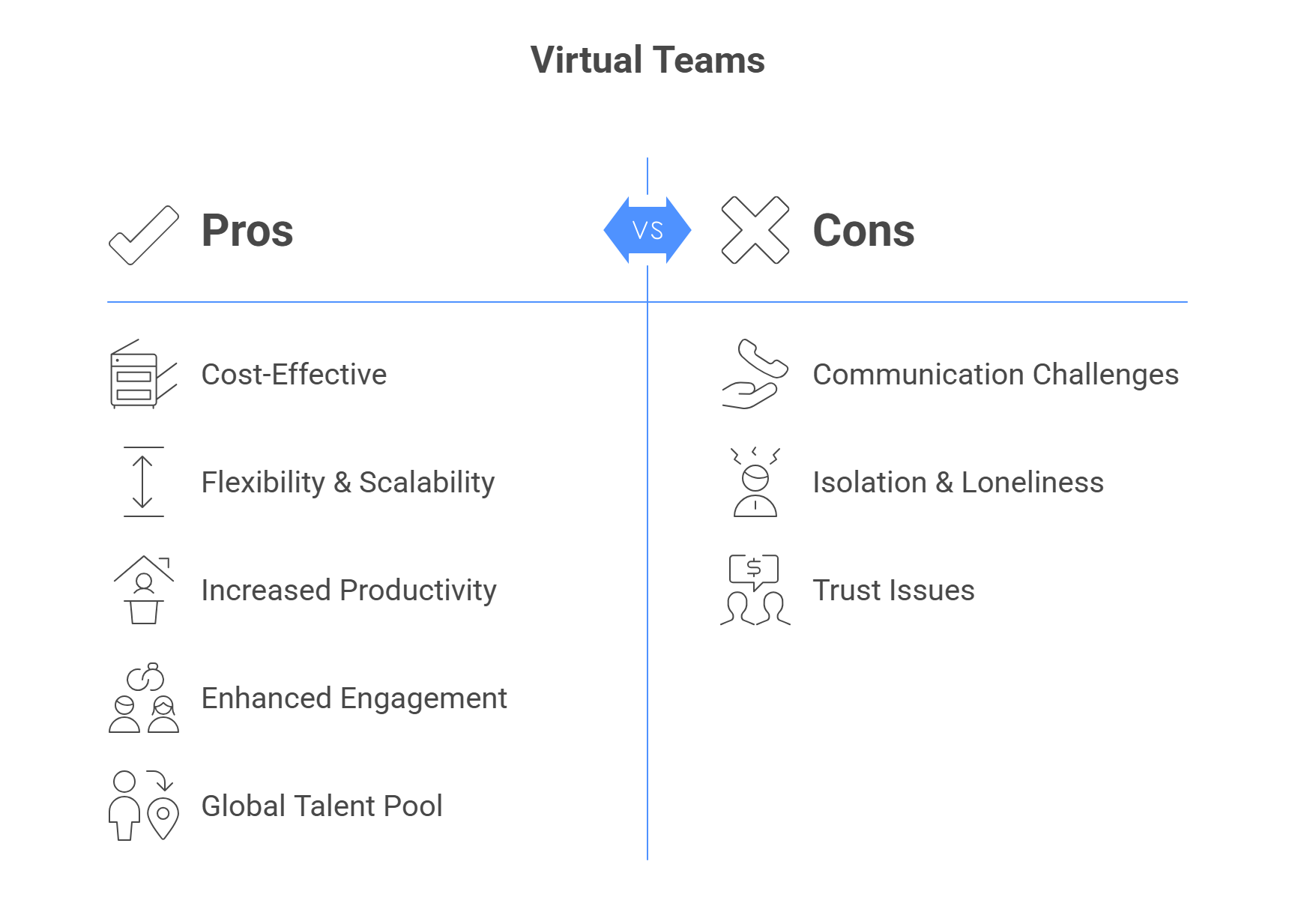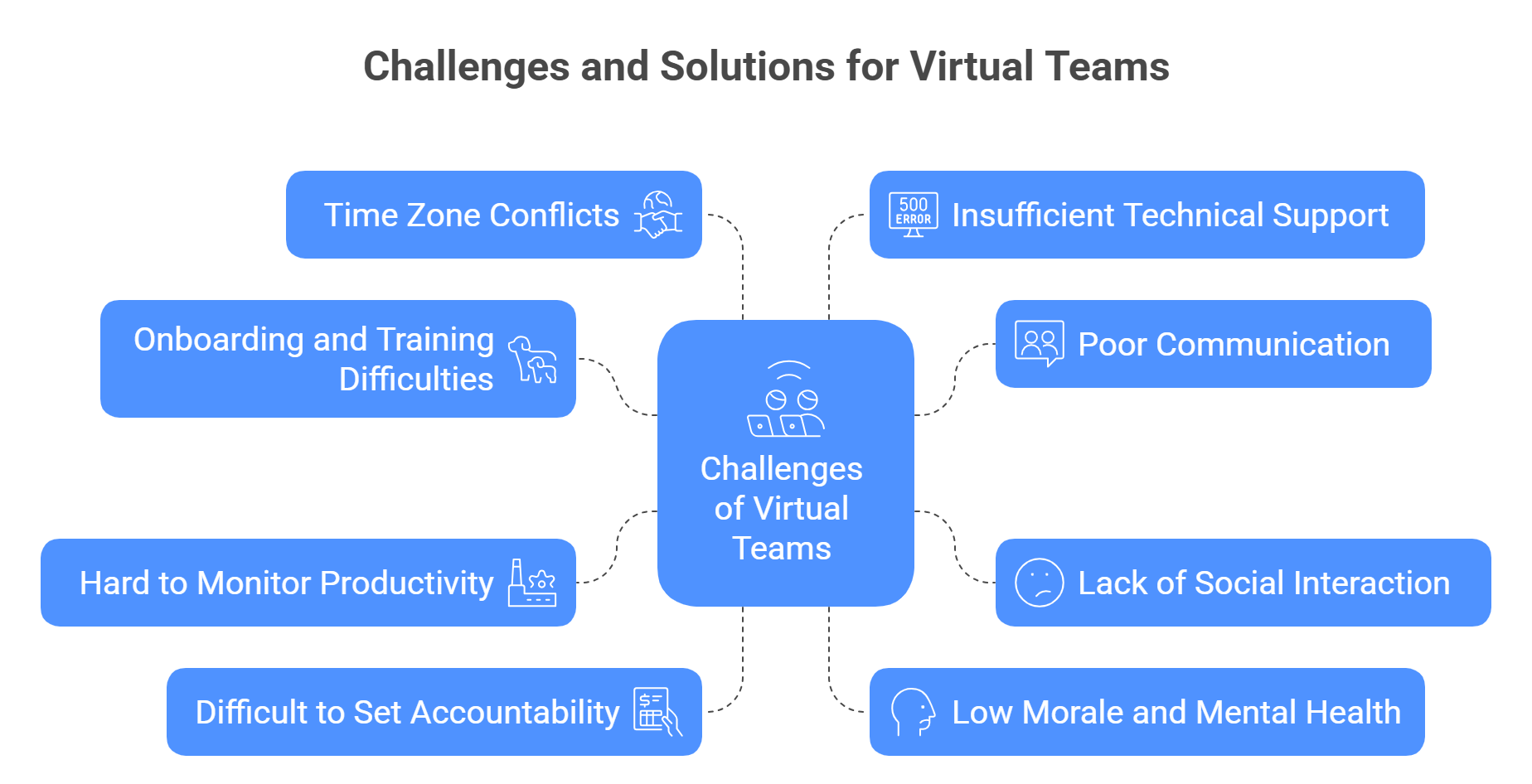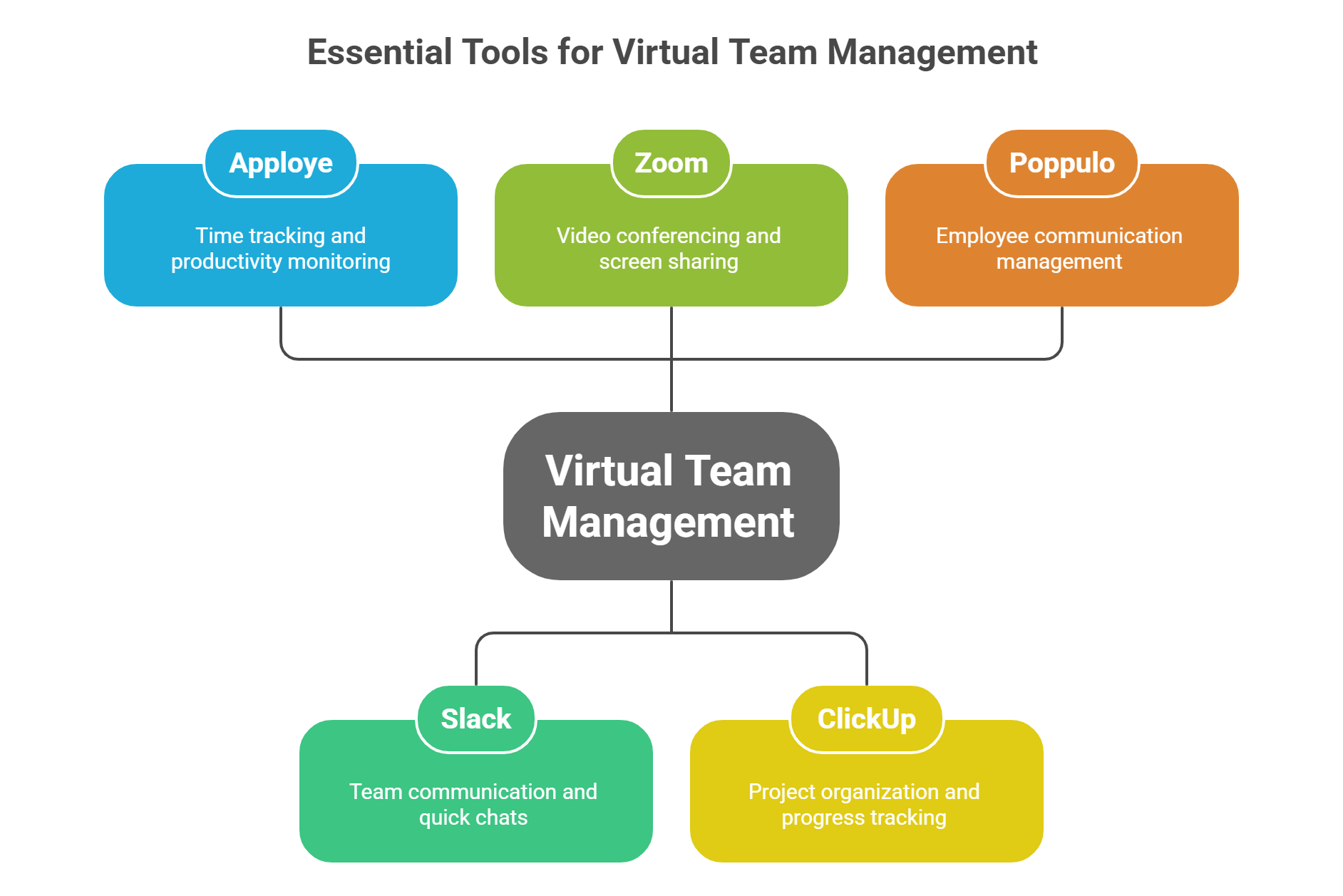Benefits of Virtual Teams in the Workplace in 2025
No Credit Card Required.

Summary:
-
Virtual teams cut office costs for both companies and staff, while opening a global talent pool. Clear roles, time tracking, and fewer meetings help you stay organized at work each day.
-
Flex work boosts focus, speed, and morale; many feel more productive at home. Use tools like Slack, Zoom, ClickUp, and Apploye to plan tasks, track time, and keep projects on one dashboard.
-
Remote work has risks: weak onboarding, poor communication, loneliness, and time zones. Fix with a buddy system, written rules, regular check-ins, and set owners for tasks to keep order.
Companies with virtual teams save around $10,600 per employee each year! Today, a solid virtual work setup isn't just good, it’s essential.
Hybrid teams help you find great talent everywhere. You can also stay competitive across different geographic locations!
In this article, we’re going to explore how these virtual work environments can make your team happier and more productive. Plus, we'll tackle communication barriers and share tips for smooth online collaboration.
In this article
- Exploring the benefits of virtual teams
- Understanding the challenges of virtual teams
- How to effectively manage your virtual teams
Benefits of Virtual Teams in the Workplace

You've probably noticed virtual teams popping up everywhere lately. And guess what? They often bring more to the table than your typical office setup. If you create the right support system for remote teams in your company, you can unlock some really great advantages.
Let's dive into what those benefits are!
Cost-Effective
Think about it – with a virtual office, companies don't have to shell out for those expensive real estate costs.
Your virtual workforce takes care of their own desks, gadgets, and even the electricity bill. For example, Dell's smart virtual work setup has saved them a whopping $39.5 million on office space.
But it's not just business owners who see the cost savings.
Your virtual workers also save a lot of money. Imagine no more daily commute costs or needing a closet full of business attire.
In fact, around 30% of remote folks save up to $5,240 each year just on travel and office-related expenses.
It's a lighter load on everyone's budget in this virtual environment!
Reduce Operational Cost
Think about the cash your business can save with virtual teams! You can seriously cut down on overhead costs. We're talking about things like rent for a physical office space, monthly utilities, and even those never-ending office supplies. Plus, you won't have those constant maintenance costs popping up!
For your team, the savings are real, too. Imagine ditching the daily commuting costs – that's a big chunk of change back in their pockets! Studies actually show that companies can save an average of around $11,000 per remote worker each year!
Think about IBM – they've saved big by using virtual teams, mainly by needing less physical office space and cutting overhead costs. Their cost reduction was nearly $50 million. It's a smart way to save money!
Enhanced Flexibility & Scalability
One of the coolest things about virtual teams is their incredible flexibility. You can easily adapt your team size to match your ever-changing business needs. For instance, if you land a big project, you can quickly scale up by bringing in specialised virtual workers from anywhere in the world!
Companies with flexible remote work policies see a 25% increase in employee retention! This business agility is especially crucial for startups and growing teams.
Imagine a new company needing a specific expert. Instead of just looking locally, they can find the perfect virtual employee from the global pool of talent!
Think about Buffer, a social media management platform. They've built a successful company with a distributed team. This shows that you can grow without being tied to a physical office or geographic location.
It's all about building your dream team, wherever they may be!
Best Remote Team Management Software and Tools
Make Employees More Productive
It might surprise you, but virtual workers often get more done than regular employees!
In fact, 77% of remote workers say they're more productive when working from home! You see tons of examples of how virtual teams ace project management even on a large scale.
But how does that even work? Isn't more monitoring supposed to mean better results?
Actually, it's often the opposite. When people have control over their schedule, they can focus better and work faster. This effective time management leads to a more productive team for your organisation.
It's about trusting your team to manage their time and deliver results. This often leads to higher employee productivity.
Effectively manage your time with Apploye
Enhance Employee Engagement
Want your virtual work setup to really shine? Give your virtual employees real responsibility! When they own their work, they get more interested.
Employees will also feel more connected to the company's business operations.
Guess what? People who work virtually most of the time (around 80%) show higher employee engagement.
Think about Trello – their virtual teams manage their work remotely using online collaboration. Engaged employees are more involved and driven, leading to better employee productivity.
Trust your team with responsibility in a virtual environment. This will boost their engagement.
It's a simple way to get everyone more invested and improve the team dynamic!
Improved Employee Satisfaction
Virtual teams can really make employees happier, especially by giving them more autonomy. What happens when they can control their schedules and workspace? They feel less stress and have better work-life balance!
Companies with remote options see about 25% higher employee retention!
This makes sense. The flexible hours and virtual setting can boost their mental health.
Remote workers save at least 40 minutes of their time every day due to no commute. This feeling of control and value makes them want to stay longer.
So, you get employee retention and better team dynamics!
Saves Time
Think about how much time gets lost in meetings that don't really go anywhere. It wastes everyone's time and the company's resources. But virtual teams can handle this smartly!
Unnecessary meetings are a thing of the past. Now, you have well-defined communication and the right communication tools. No more imbalance in your personal life!
For instance, instead of a meeting, teams can use digital communication platforms. Try Asana for project updates and feedback.
Zapier prefers clear written communication and focused virtual check-ins, not lengthy meetings. You can also try employee monitoring tools!
This way, business owners save a ton of time and resources. Now, the business operations are way more efficient.
Global Talent Pool
Forget about being limited by local hires! With a virtual setup, you can tap into a global pool of talent and find highly skilled people anywhere.
Traditionally, you'd be stuck choosing from your city or paying a lot to move someone. This is difficult for smaller business owners.
But virtual workflow changes everything. You can access amazing talent worldwide without breaking the bank. Plus, you can find cost-effective virtual assistants or workers from different geographic locations. This will increase your cost savings.
Think about companies like Automattic, the company behind WordPress. They hire talent from over 90 countries – proof that a global approach works wonders!
This opens up incredible advantages to business owners. Now, you can get the best people without the usual financial strain.
24/7 Availability
Building a virtual team lets you hire a really diverse bunch of people. This gives you access to a wider range of proven talents.
Your virtual workers are spread across different time zones. So, you can offer 24/7 service to your clients without overworking anyone!
Imagine having team members in Australia and others in England. Now you can easily get employee data!
Plus, having virtual employees brings in different cultures and fresh ideas. This will spark creativity within your organisation.
It's a smart way to boost your business operations and tap into varied perspectives.
Easy to scale
Want to grow your business? The old way meant more office space, equipment, and furniture – a costly and slow process.
But scaling a virtual team is way easier! You skip all that. Just get the right remote work tool and smooth out your onboarding.
Then, you're set to quickly expand your company in this virtual environment. Companies like Zoom scaled massively to meet demand with a virtual workforce.
It’s about smart growth without the traditional overhead.
Challenges of Virtual Teams

Sure, there are many virtual team advantages , but they also come with a few potential bumps in the road. It's good to be aware of these challenges upfront. Knowing the potential problems helps you create a great virtual workspace. Then you can avoid those problems altogether.
Here are some things to keep in mind -
Onboarding and Training Difficulties
Virtual onboarding for virtual teams can sometimes feel distant or disconnected. New virtual employees might feel lost without the clear structure of a physical office environment.
Imagine starting a new job and only receiving a bunch of documents with no real human connection. It can be overwhelming!
Statistics show that 1 out of 5 new hires leaves within the first 45 days of a new job.
Making New Hires Feel Connected
To tackle this, create interactive onboarding materials that go beyond just text. Think engaging videos and virtual tours of the company culture. Keep a clear step-by-step guide for their first few weeks!
The Buddy System Solution
Even better, install a "buddy system" where a current employee or a team leader is paired with the new hire.
These team leaders can answer questions and help them navigate the virtual environment. So, the onboarding process will be much smoother and more effective.
This personal touch can significantly improve employee satisfaction and employee retention!
For example, GitLab pairs new hires with mentors for their first few months. The mentors guide them and integrate them into their culture.
Poor Communication
Let's be real, communication barriers can really trip up virtual teams if you don't set things up right.
Studies show that after involving employees in decisions, you need to keep them engaged (24%).
So, make clear asynchronous communication policies. Get the right communication tools and train your team.
Focus on strong digital communication and try different remote ways to connect. This makes your team stronger and avoids headaches.
Lack of Social Interaction
A big part of office life is having fun together, like hallway chats and celebrating holidays. But in a remote workplace, it can feel like just emails. Loneliness is becoming a real issue for remote workers. Did you know that 27% of remote workers report feeling lonely?
Good communication and virtual team management tools can help! Try weekly casual video calls and play online games together. Make sure to have virtual team-building activities for better team cohesion.
This will combat social isolation among team members!
Hard to Monitor Productivity
The latest Android device management tools help you set up rules and security for virtual employees. This keeps productivity up, even when everyone's working from different geographic locations. Remotely, it can be tough to know if the team is actually working or just browsing the internet.
But using remote time tracking software and productivity monitoring tools makes this much easier. These tools can show exactly how your virtual workforce spends its time. Now you'll know they're working hard or taking too many breaks.
Get clear insights into team performance in this virtual environment!
Use Apploye’s monitoring features for more productivity
Difficult to Set Accountability
Setting accountability can be tough with virtual teams. When it's unclear who's responsible for what, you can see team clashes and delays.
The fix? Task management tools are your best bet. You can assign tasks, track progress, and see everything on one dashboard.
This makes each virtual worker clearly accountable for their assigned work. You get better team performance and streamlined business operations.
Google Tools for Project Management
Low Morale and Mental Health
Feeling disconnected can really affect the mental well-being of remote workers. Mental health definitely plays a big role in how productive and well they perform. This is more important with all the uncertainties around.
So, companies should be understanding and offer mental health support, like counselling.
Another great way is recognising good work and offering extra healthcare perks. These can help virtual employees feel more secure and valued.
Now, you can have more employee satisfaction in this virtual environment!
Time Zone Conflicts
Having remote workers across time zones boosts diversity and 24/7 support. But managing them all can be chaotic for one person. A smart move is to assign managers based on time zone similarities.
Using a central time tracking tool like Apploye also helps a lot. This way, you can effectively manage your global virtual workforce!
No more worrying about where your team members are located!
Insufficient Technical Support
Sometimes, company leaders don't give virtual teams good collaboration and management tools. That's when it can get really messy. Before you even start building a remote team, you need to make sure your tech setup is solid.
The good news is, there are lots of affordable tools out there. These can help remote workers stay connected and productive in a virtual environment.
Getting the tech right from the start is key to successful virtual team management.
How You Can Manage Your Virtual Teams

There are many challenges with virtual teams. But one thing really stands out! You've got to have the right virtual team collaboration tools. These tools are the backbone of a successful remote environment.
Without strong tech support, managing virtual teams is impossible. So, getting the right tools is essential for effective virtual team management.
This way, you’ll also have a productive virtual workforce.
Here are a few tools that virtual teams need:
- Apploye: This is a smart time tracking app that even takes screenshots. It's designed to monitor remote teams and can boost efficiency by around 20%! Apploye helps keep your virtual employees productive and motivated.
- Slack: Think of Slack as your team's digital water cooler. It's a team communication software perfect for quick chats and asking questions. Now you can keep everyone in the loop.
- Zoom: When you need to see each other face-to-face (virtually!), Zoom is the top video conferencing app. It lets you host virtual team meetings and share screens. So, your communication will be smoother.
- ClickUp: Want to get projects organised and track progress? Try ClickUp! It gives you a central dashboard to see where everything stands.
- Poppulo: This software focuses on connecting with your key people. They can be the employees, customers, and more. It helps you manage your employee communications in a virtual environment.
Manage your virtual teams easily
Conclusion
So, virtual teams offer big wins. You get cost savings, flexibility, and happier, productive employees. Sure, there are hurdles like onboarding and communication. But with the right tools and smart management, you can easily tackle these challenges!
Switching to virtual work lets you hire great people from anywhere. That's why working virtually is a smart and powerful way to do things now and in the future.
FAQs
What is a virtual team?
Think of it as a team working together, but not in the same office. They use the internet and cool tech to get things done from wherever they are. This means you can have people from all over working together!
Why should you build a remote team in your business?
Going remote lets you find great talent all over the world, saves you money on office costs, and gives your team more freedom. Happy workers often mean better work!
How to manage your virtual team?
To lead a virtual team well, make sure everyone knows what they're doing and when. Use advanced online management tools to talk and plan. Trust your team and help them feel like they're still connected.
Why are virtual teams important?
Virtual teams are a big deal because they let you hire the best people, no matter where they live. They also help businesses be more flexible and save money. Plus, lots of people really like working remotely.
What are the benefits of using virtual team-building activities for remote teams?
Playing games and doing fun stuff online helps remote teams connect and feel closer, even when they're far apart. It makes talking easier and boosts everyone's spirits.
How can virtual teambuilding be meaningful and impactful?
Make your online team fun by choosing activities everyone can join and that are actually interesting. Focus on things that help people chat and get to know each other better. The goal is a real connection!
What are the advantages of a virtual organisation?
Fully online companies save money on offices and can hire the best people from anywhere. Their teams often have great flexibility. This can make employees happier and stick around longer.
What are the benefits and drawbacks of hosting a virtual meeting?
Online meetings are handy because everyone can join from anywhere. You can easily share your screen! But sometimes, it's harder to really connect, and tech problems can be annoying.
What makes virtual collaboration so important in the digital age?
Since we're all so connected online, being able to work well together online is key. It lets teams work smoothly, no matter where they are, and helps companies move quickly.
What is better, virtual teams or in-house teams?
Neither is always best – it depends on what a company needs. Virtual teams offer flexibility and more talent options. Whereas office teams can build stronger in-person relationships. Sometimes, a mix is the best way to go.
Why is virtual communication important?
Talking online with your team keeps everyone on the same page, no matter where they're working. Good online chat helps avoid confusion and keeps projects moving forward.
Are virtual team-building sessions effective?
Yes, online team games can be a great way for remote teams to bond and have fun together. They help people relax and connect in a more casual way.
What are the benefits and drawbacks of managing a team of remote employees?
Leading remote teams lets you hire great people from anywhere and give them freedom. But you need to be really good at communicating and trusting your team when you can't see them in person.
What are some of the advantages of using a virtual meeting space?
Online meeting rooms are affordable and easy for everyone to access. They usually have useful features like screen sharing. They make it simple for teams to meet up online, no matter where they are.

